Are you looking to supercharge your digestive system and boost your overall well-being? Look no further than the world of fermented vegetables! Fermented foods have been a staple in many cultures around the world for centuries, and it’s easy to see why. Not only do they add a tangy burst of flavor to any meal, but they’re also packed with gut-friendly probiotics that can help regulate your digestive system and even support immune function.
In this article, we’ll dive into 18 tangy fermented vegetable recipes that are sure to tantalize your taste buds and nourish your body. From spicy kimchi to crunchy sauerkraut, each recipe is carefully crafted to bring out the best flavors of its ingredient vegetables. So whether you’re a seasoned fermenter or just starting out on this gut-friendly journey, we’ve got you covered!
Spicy Fermented Kimchi with Napa Cabbage
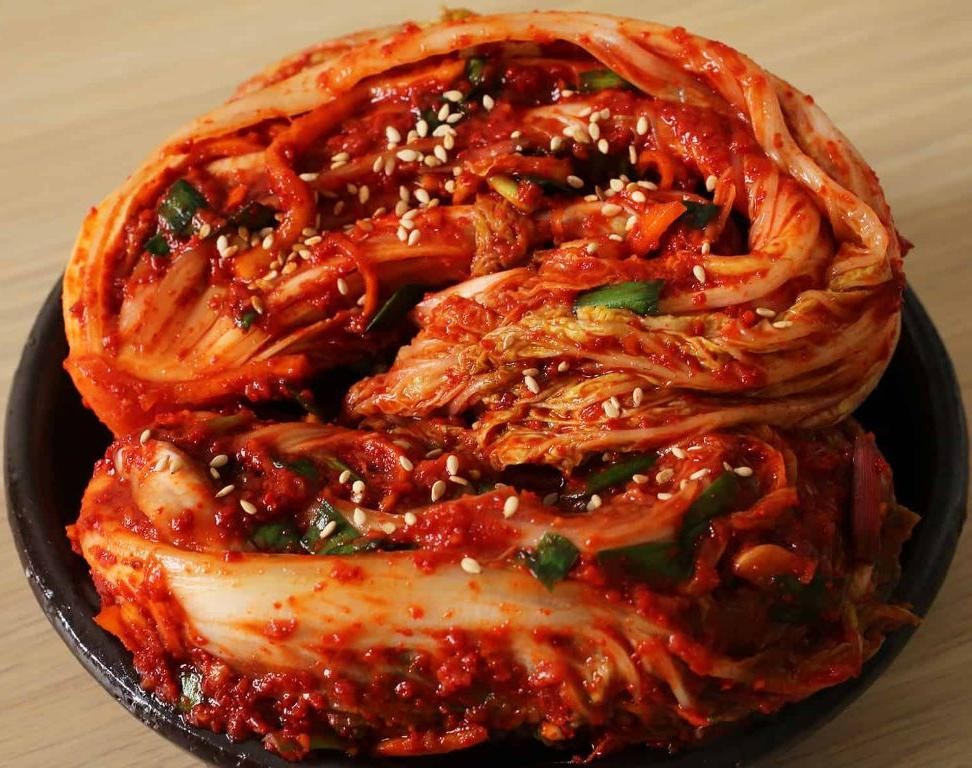
Kimchi, a staple Korean condiment, is a spicy fermented vegetable dish that adds depth and excitement to any meal. This recipe for Spicy Fermented Kimchi with Napa Cabbage uses a classic combination of ingredients to create a bold and tangy flavor profile.
Ingredients:
– 2 lbs napa cabbage, thinly sliced
– 2 cups Korean chili flakes (gochugaru)
– 1/4 cup fish sauce
– 1/4 cup rice vinegar
– 1/4 cup water
– 2 cloves garlic, minced
– 1 tablespoon grated ginger
– 1/4 cup chopped scallions, for garnish
Instructions:
1. In a large bowl, combine cabbage, chili flakes, fish sauce, rice vinegar, and water. Massage the mixture with your hands for 5-7 minutes to help release the natural juices from the cabbage.
2. Add garlic and ginger to the bowl and mix well.
3. Pack the kimchi mixture into a jar or container, pressing down firmly to remove any air pockets. Leave about an inch at the top.
4. Cover the jar with cheesecloth or a clean cotton cloth, securing it with a rubber band.
5. Let the kimchi ferment at room temperature (68-72°F) for 1-5 days, shaking the jar daily to aid in fermentation.
Cooking Time: None required! Just let it ferment and enjoy.
Garlic-Dill Fermented Pickles
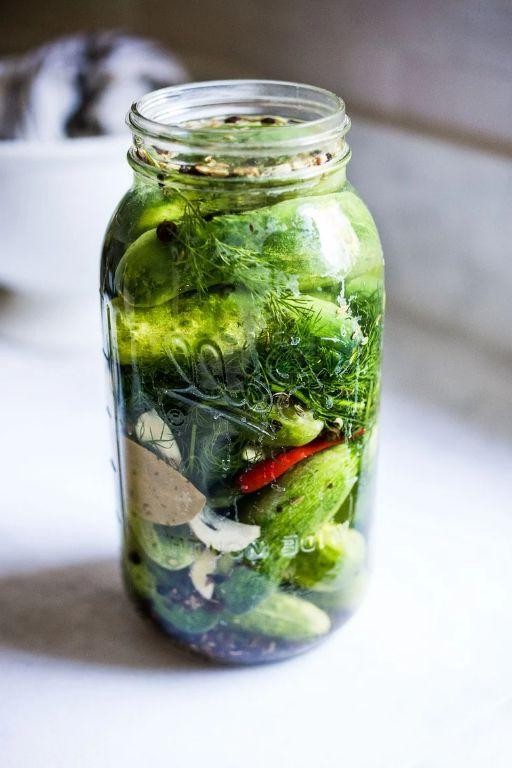
This recipe yields a tangy and refreshing batch of pickles with a subtle garlic kick, perfect for snacking or adding a burst of flavor to sandwiches.
Ingredients:
– 4 cups thinly sliced cucumbers
– 1/2 cup (120ml) water
– 1/4 cup (60g) granulated sugar
– 1/4 cup (30g) pickling salt
– 3 cloves garlic, minced
– 1/4 cup (15g) fresh dill weed
– 1 tsp (5g) caraway seeds (optional)
Instructions:
1. In a large bowl, combine sliced cucumbers and water. Let it sit for 2 hours to allow the cucumbers to release their natural juices.
2. Drain the liquid and add sugar, pickling salt, garlic, dill weed, and caraway seeds (if using). Mix until the solids are evenly distributed.
3. Pack the pickle mixture into a clean glass jar or container, leaving about 1 inch of headspace.
4. Weight down the pickles with a plate or stone to keep them submerged under their juices.
5. Store the jar at room temperature (68°F-72°F/20°C-22°C) for 3-7 days to allow fermentation.
Cooking Time: 3-7 days
Fermented Carrot Sticks with Turmeric
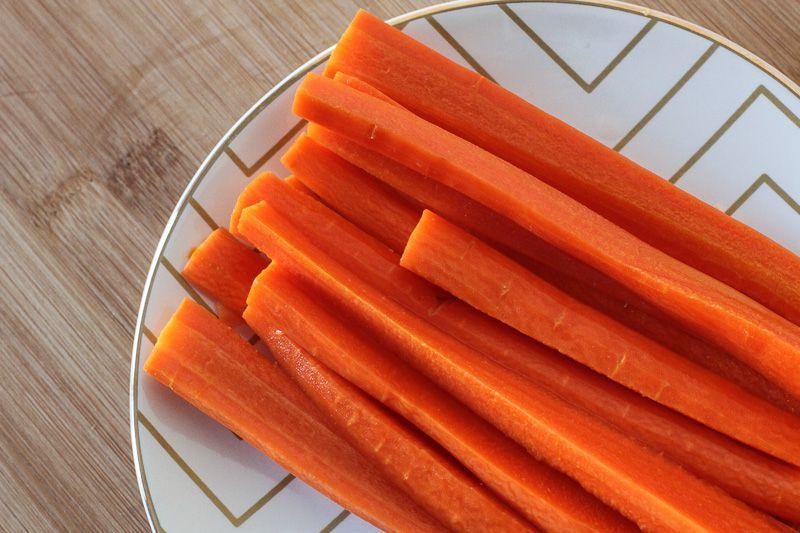
This recipe combines the sweetness of carrots with the earthy warmth of turmeric, creating a tangy and nutritious fermented snack. By allowing the mixture to ferment, you’ll cultivate beneficial probiotics that support gut health.
Ingredients:
– 2 cups carrot sticks (about 4-6 medium-sized carrots)
– 1/2 cup water
– 1 tablespoon active culture yogurt or probiotic powder
– 1 teaspoon grated turmeric root
– Salt (optional)
Instructions:
1. In a large bowl, combine the carrot sticks and water. Let it sit for at least 4 hours to allow the carrots to soften.
2. Stir in the active culture yogurt or probiotic powder until well combined.
3. Add the grated turmeric and mix until the mixture is evenly colored.
4. Transfer the mixture to a glass jar with a wide mouth, leaving about an inch of space at the top. Cover with a cloth or paper towel to keep out dust.
5. Place the jar in a cool, dark spot (around 68°F-72°F) for 2-3 days to allow fermentation to occur. You may start to see bubbles and a tangy aroma develop.
6. Once fermented to your liking, store the carrots in the refrigerator to slow down the fermentation process.
Cooking Time: 0 hours
Probiotic Fermented Sauerkraut
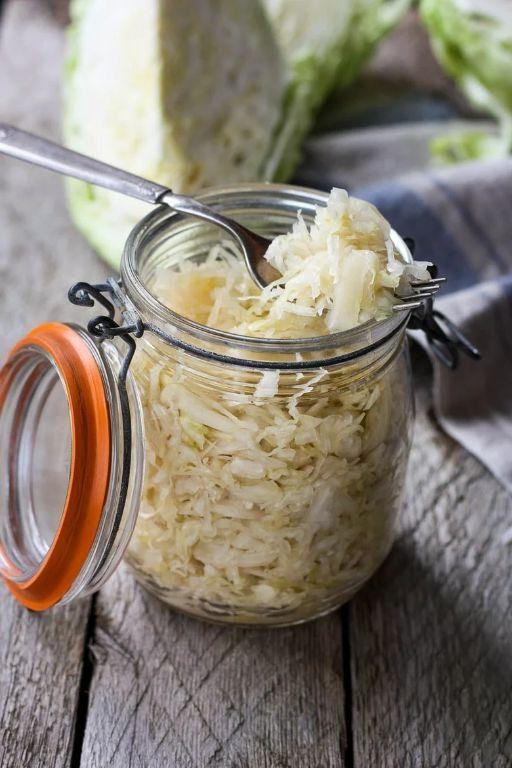
Start your day with a tangy and nutritious boost by making your own probiotic fermented sauerkraut at home. This recipe is easy to follow and requires minimal equipment, resulting in a deliciously sour condiment packed with beneficial bacteria.
Ingredients:
– 5 lbs (2.3 kg) of cabbage, shredded
– 1 tablespoon of sea salt
– 1/4 cup (60 ml) of water
– Optional: caraway seeds or juniper berries for flavor
Instructions:
1. In a large bowl, massage the shredded cabbage with your hands for about 5 minutes to release its juices.
2. Add the sea salt and mix until the cabbage is evenly coated.
3. Pack the cabbage mixture into a clean glass jar or crock, pressing down firmly to eliminate air pockets.
4. Pour in the water, making sure the cabbage is covered by at least an inch (2.5 cm) of liquid.
5. Cover the jar with cheesecloth or a breathable lid and let it ferment at room temperature (68°F/20°C) for 3-6 weeks.
Cooking Time:
– Fermentation time: 3-6 weeks
Fermented Radish Slices with Ginger
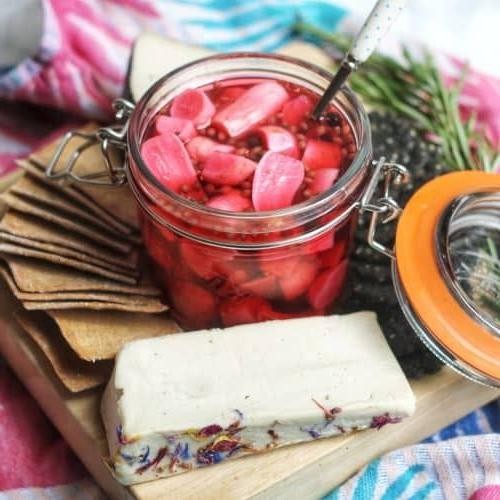
This recipe is a great way to add some excitement to your fermented foods collection. Fermented radish slices with ginger are a perfect addition to any meal, offering a burst of flavor and a good dose of probiotics.
Ingredients:
– 1 large daikon radish, peeled and sliced into 1/8-inch thick rounds
– 2 inches fresh ginger, peeled and sliced into thin coins
– 1 tablespoon sea salt
– 1 cup water
Instructions:
1. In a large bowl, combine the sliced radish and ginger.
2. Sprinkle the sea salt over the mixture and toss to coat evenly.
3. Pack the mixture into a clean glass jar or container, pressing down firmly to remove any air pockets.
4. Pour in the water, making sure that all of the radish and ginger are submerged.
5. Cover the jar with a lid or cheesecloth and let it ferment at room temperature (around 68°F) for 3-5 days, shaking the jar daily.
Cooking Time: 3-5 days
Fermented Beet Kvass
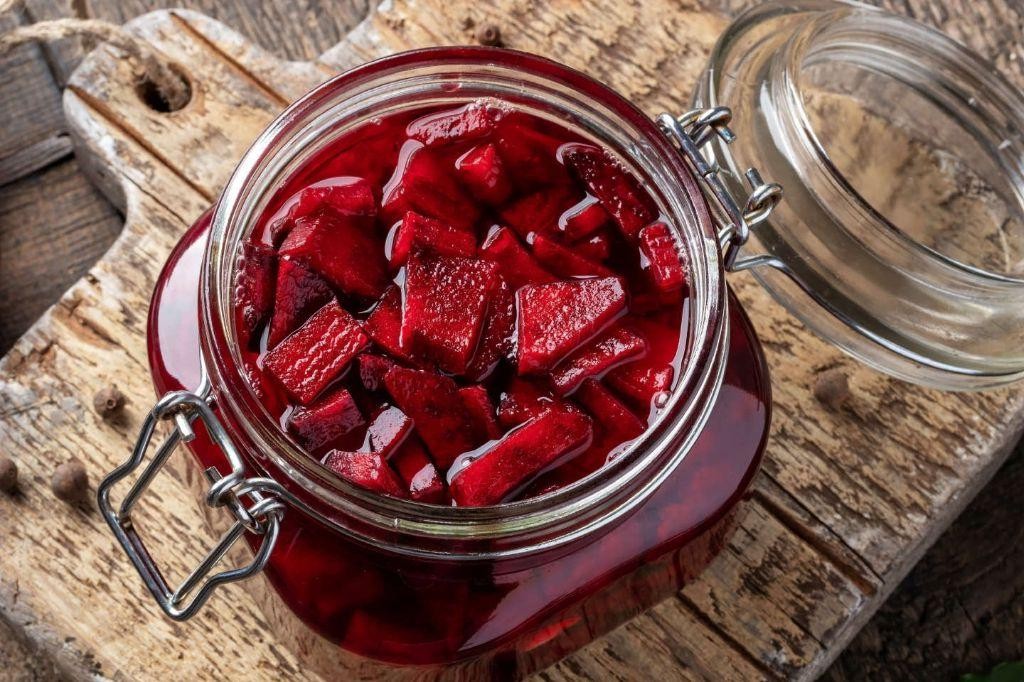
Kvass, a traditional Eastern European fermented beverage, is a refreshing and probiotic-rich drink made with beets, water, and sugar. This recipe uses beets as the main ingredient to create a sweet and earthy kvass.
Ingredients:
– 2 lbs beets
– 1 gallon water
– 1/4 cup granulated sugar
– 1/4 teaspoon active dry yeast (optional)
Instructions:
1. Wash and chop the beets into small pieces.
2. In a large pot, combine the chopped beets and gallon of water. Bring to a boil, then reduce heat and simmer for 20-25 minutes, or until the beets are tender.
3. Strain the beet mixture through a cheesecloth or fine-mesh sieve into a large bowl or container. Discard the solids.
4. Add the sugar and stir until dissolved. Allow the mixture to cool to room temperature.
5. Cover the container with a cloth or plastic wrap and let ferment at room temperature (68-72°F) for 2-3 days, or until the liquid becomes slightly carbonated and sour-tasting. If using yeast, add it after 24 hours of fermentation.
6. Strain the kvass through a cheesecloth or fine-mesh sieve into a clean container. Store in the refrigerator to slow down fermentation.
Cooking Time: 2-3 days (fermentation time)
Fermented Jalapeño Peppers
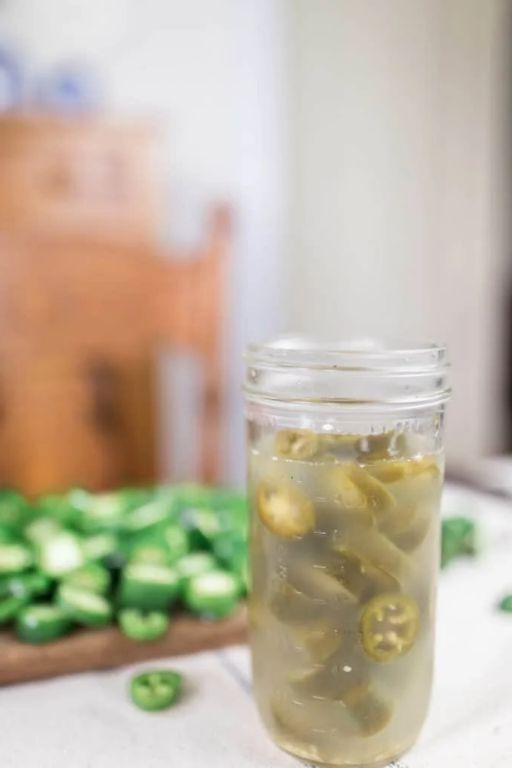
Add a tangy kick to your meals with these fermented jalapeño peppers! With minimal effort and a few simple ingredients, you can create a delicious condiment that’s perfect for snacking, cooking, or as a topping.
Ingredients:
– 1 lb jalapeño peppers, sliced into thin rings
– 1 cup water
– 1 tablespoon salt
– 1 tablespoon sugar
– 1/4 teaspoon starter culture (such as sauerkraut juice or active dry yeast)
Instructions:
1. In a large bowl, combine the sliced jalapeños and water.
2. Add the salt, sugar, and starter culture to the mixture. Stir until the sugar is dissolved.
3. Pack the mixture into a clean glass jar, leaving about 1 inch of headspace at the top.
4. Weight the peppers down with a plate or stone to keep them submerged in the liquid.
5. Store the jar in a cool, dark place (around 65°F to 75°F) for 3-6 weeks, shaking the jar every few days to help fermentation progress.
6. Once the peppers have reached your desired level of sourness and spiciness, transfer them to the refrigerator to slow down fermentation.
Cooking Time: 0 hours
Notes: Fermented jalapeños can be stored in the refrigerator for up to a year. Use them as a topping, add them to sandwiches, or enjoy them as a snack.
Fermented Green Tomato Relish
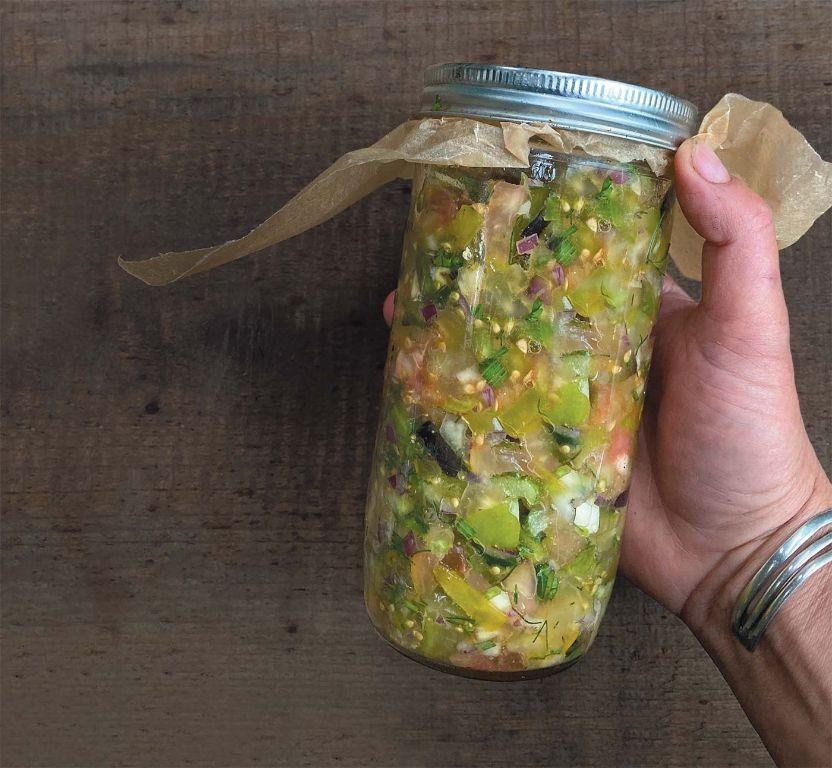
Fermented Green Tomato Relish Recipe: A Tangy Twist on Traditional Condiments
This recipe transforms green tomatoes into a tangy and crunchy relish, perfect for topping burgers, sandwiches, or using as a side dish.
Ingredients:
– 4 cups green tomatoes, chopped
– 1 cup water
– 1 tablespoon sea salt
– 1/2 teaspoon black pepper
– 1/4 teaspoon red pepper flakes (optional)
– 1/4 cup whey or active culture start (available at health food stores)
Instructions:
1. In a large bowl, combine chopped green tomatoes and sea salt. Massage the mixture with your hands for 5-7 minutes to help release juices.
2. Add water, black pepper, and red pepper flakes (if using). Mix well.
3. Cover the bowl with cheesecloth or a clean cotton cloth. Let it sit at room temperature (68°F – 72°F) for 24 hours.
4. After 24 hours, stir in whey or active culture start. Transfer the mixture to a glass jar and refrigerate.
5. Allow the relish to ferment for 3-5 days, or until it reaches your desired level of tanginess.
Cooking Time: None needed! Fermenting occurs naturally at room temperature.
Fermented Red Onion Rings
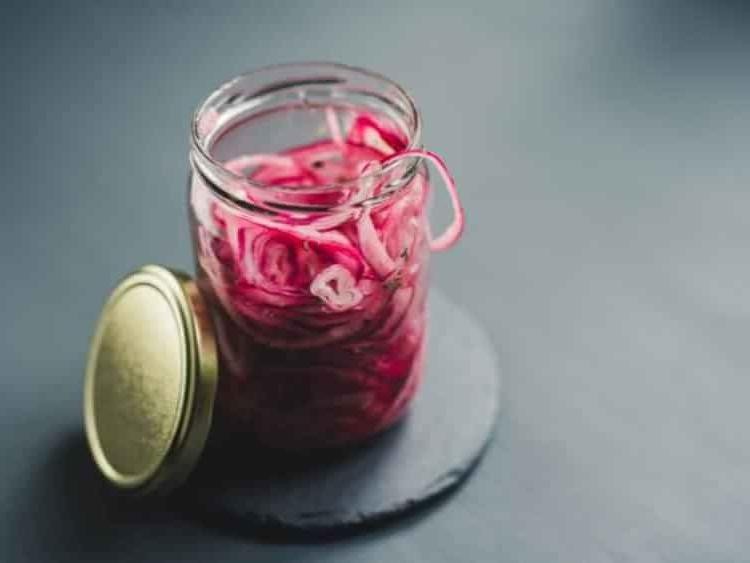
Transform ordinary onion rings into a tangy, umami-rich snack with this simple fermented recipe. Perfect as a side dish or topping for burgers and sandwiches.
Ingredients:
– 1 large red onion, thinly sliced
– 1/4 cup kosher salt
– 1/4 cup water
– 1 tablespoon sugar
– 1 tablespoon apple cider vinegar
– 1/2 teaspoon caraway seeds (optional)
Instructions:
1. In a large bowl, combine sliced onions and kosher salt. Massage the mixture with your hands for 5 minutes to release juices.
2. Add water, sugar, and apple cider vinegar. Mix until the salt is dissolved.
3. Cover the bowl with cheesecloth or a clean cotton cloth. Let it sit at room temperature (68°F – 72°F) for 24-48 hours, stirring occasionally.
4. After fermentation, rinse the onion rings with cold water to remove excess brine.
5. Pat dry with paper towels and add caraway seeds if desired. Store in an airtight container in the refrigerator.
Cooking Time:
– Fermentation time: 24-48 hours
– Refrigeration time: at least 2 hours before serving
Fermented Daikon Radish Spears
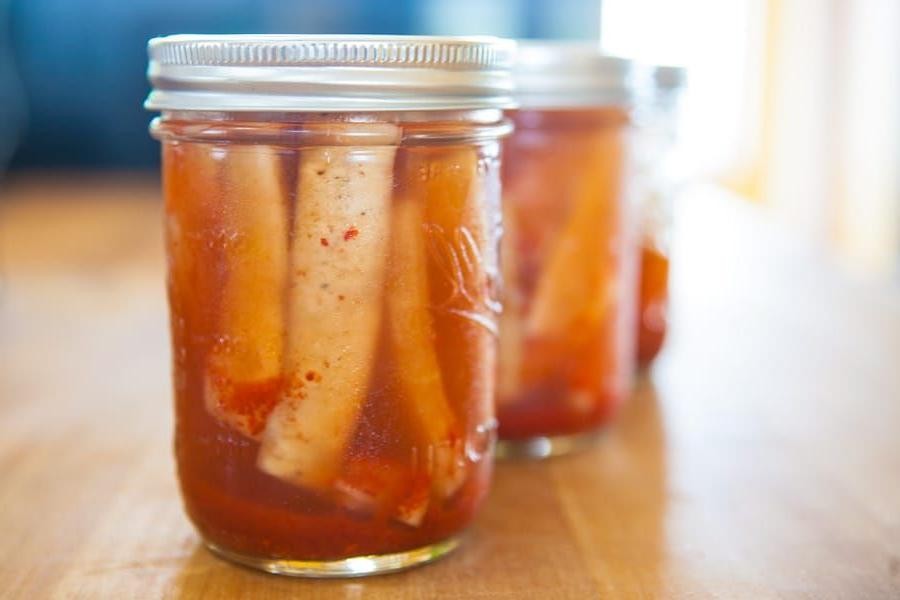
This recipe transforms daikon radishes into a tangy and crunchy snack, perfect for adding a burst of flavor to any meal. The fermentation process brings out the natural sweetness in the radishes, while the spears retain their crunchy texture.
Ingredients:
– 1 large daikon radish
– 1/4 cup Korean chili flakes (gochugaru)
– 1/4 cup sea salt
– 1/2 gallon water
– Optional: garlic cloves and/or green onions for garnish
Instructions:
1. Cut the daikon radish into spears, approximately 4-6 inches long.
2. In a large bowl, mix together Korean chili flakes and sea salt.
3. Add the daikon radish spears to the bowl and toss to coat evenly with the spice mixture.
4. Pack the daikon radish spears into a jar or container, leaving about 1 inch of space at the top.
5. Pour the water over the radishes, making sure they are completely submerged.
6. Cover the jar or container with cheesecloth or a clean cloth and secure with a rubber band.
7. Let the daikon radish spears ferment at room temperature (68-72°F) for 3-4 weeks, shaking the jar once a week.
Cooking Time: None needed! Just let it ferment!
Fermented Mixed Vegetable Medley
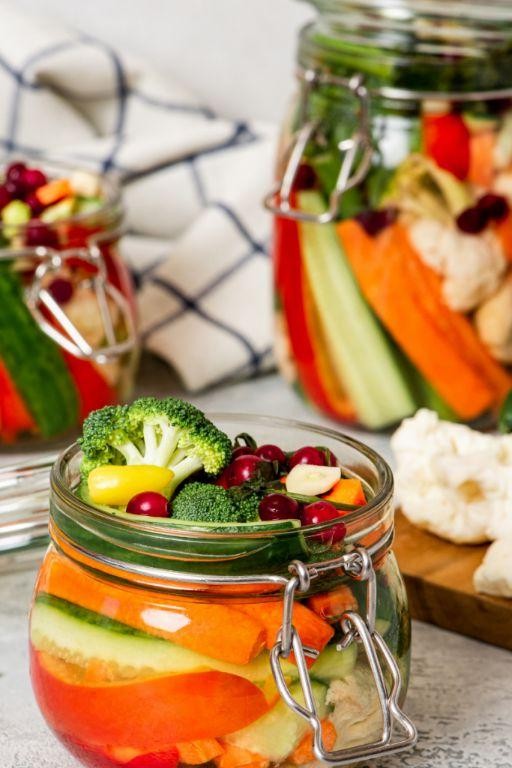
This recipe creates a deliciously tangy and probiotic-rich fermented vegetable medley, perfect for adding a nutritious twist to any meal. With a mix of colorful vegetables, this dish is not only flavorful but also visually appealing.
Ingredients:
– 2 cups mixed vegetables (such as carrots, beets, cabbage, bell peppers, and onions)
– 1 tablespoon sea salt
– 1/4 cup water
– 1 tablespoon fermented vegetable starter culture (or 1 tablespoon active dry yeast)
Instructions:
1. Chop the mixed vegetables into bite-sized pieces.
2. In a large bowl, mix together the chopped vegetables, sea salt, and water until they are well coated.
3. Pack the mixture tightly into a clean glass jar or container, leaving about 1 inch of space at the top.
4. Sprinkle the fermented vegetable starter culture (or active dry yeast) over the top of the mixture.
5. Cover the jar with a cloth or paper towel to keep dust out and let it sit in a cool, dark place for 3-7 days, or until the fermentation process is complete.
Cooking Time: 3-7 days
Fermented Cucumber and Dill Salad
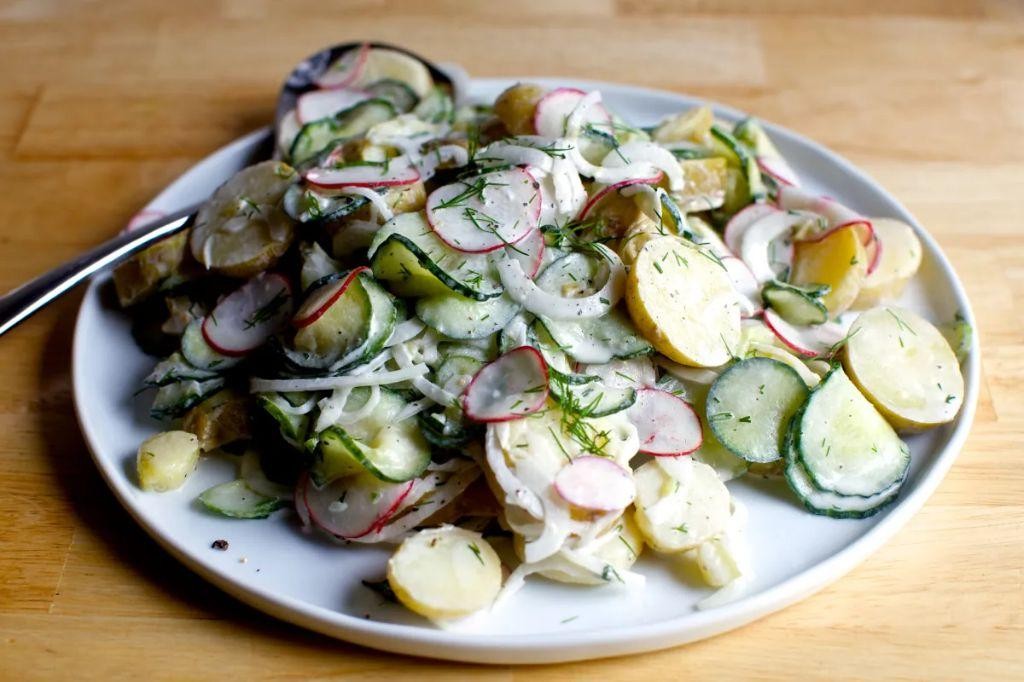
This refreshing salad combines the tangy flavors of fermented cucumbers with the brightness of fresh dill, perfect for a light and healthy snack or side dish.
Ingredients:
– 4-6 Kirby cucumbers
– 1/2 cup water
– 1 tablespoon sea salt
– 1/4 cup chopped fresh dill
– 2 tablespoons apple cider vinegar (optional)
Instructions:
1. Slice the cucumbers into thin rounds and place them in a clean glass jar.
2. Mix the water and sea salt, and pour it over the cucumbers, making sure they are completely submerged.
3. Cover the jar with a cloth or plastic wrap and let it ferment at room temperature for 24-48 hours.
4. Just before serving, stir in the chopped fresh dill and apple cider vinegar (if using).
5. Taste and adjust the seasoning as needed.
Cooking Time: 24-48 hours fermentation time
Fermented Garlic Scapes

Elevate your kitchen with this simple and flavorful recipe that turns garlic scapes into a tangy, fermented delight. With just a few ingredients and some patience, you’ll be rewarded with a condiment perfect for adding zing to any dish.
Ingredients:
– 1 cup garlic scapes
– 1/4 cup water
– 1 tablespoon salt
– 1/2 teaspoon caraway seeds (optional)
– 1/4 teaspoon black pepper
Instructions:
1. Rinse the garlic scapes and pat dry with paper towels.
2. In a clean glass jar, combine the scapes, water, salt, caraway seeds (if using), and black pepper.
3. Weigh down the scapes with a small plate or stone to keep them submerged under the liquid.
4. Cover the jar with cheesecloth or a coffee filter, securing it with a rubber band.
5. Place the jar in a cool, dark spot (around 65°F to 70°F) for 3-6 weeks, shaking the jar every few days to maintain even fermentation.
6. Once the fermentation process is complete, transfer the fermented garlic scapes to an airtight container and store it in the refrigerator.
Cooking Time: 0 minutes
Fermented Brussels Sprouts with Mustard Seeds
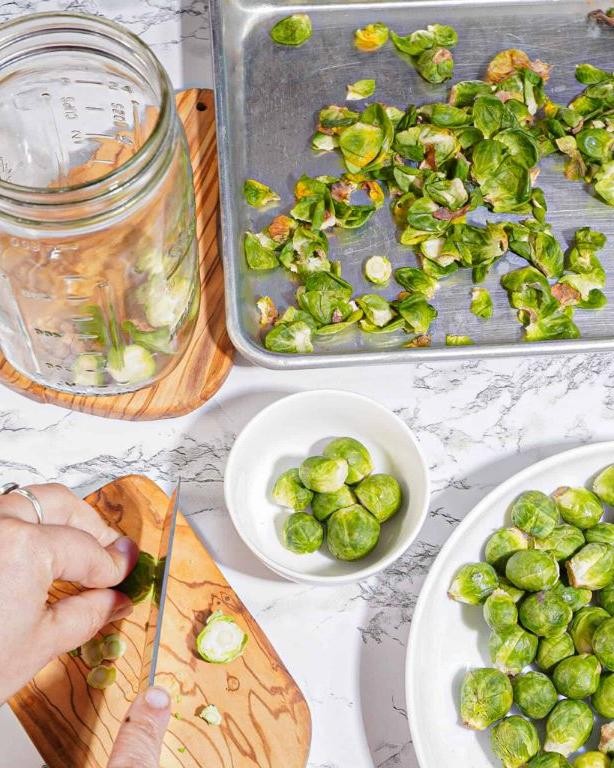
This recipe takes the humble Brussels sprout to new heights by fermenting it with mustard seeds, creating a tangy and umami-rich condiment perfect for topping sauerkraut or serving as a side dish.
Ingredients:
– 1 lb (450g) Brussels sprouts, trimmed and halved
– 2 tbsp (30g) mustard seeds
– 1/4 cup (60ml) water
– 1/4 cup (60g) salt
– 2 cloves garlic, minced (optional)
Instructions:
1. In a large bowl, combine Brussels sprouts, mustard seeds, and water.
2. Mix until the sprouts are evenly coated with the mustard seed mixture.
3. Add salt and mix until dissolved.
4. Transfer the mixture to a clean glass jar or container with a wide mouth.
5. Pack the mixture down tightly, leaving about 1 inch (2.5 cm) of space at the top.
6. Secure the lid and let it ferment at room temperature for 3-5 days, shaking daily.
7. Once fermented, store in the refrigerator to slow down fermentation.
Cooking Time: 0 minutes (fermenting time varies)
Fermented Cauliflower Florets
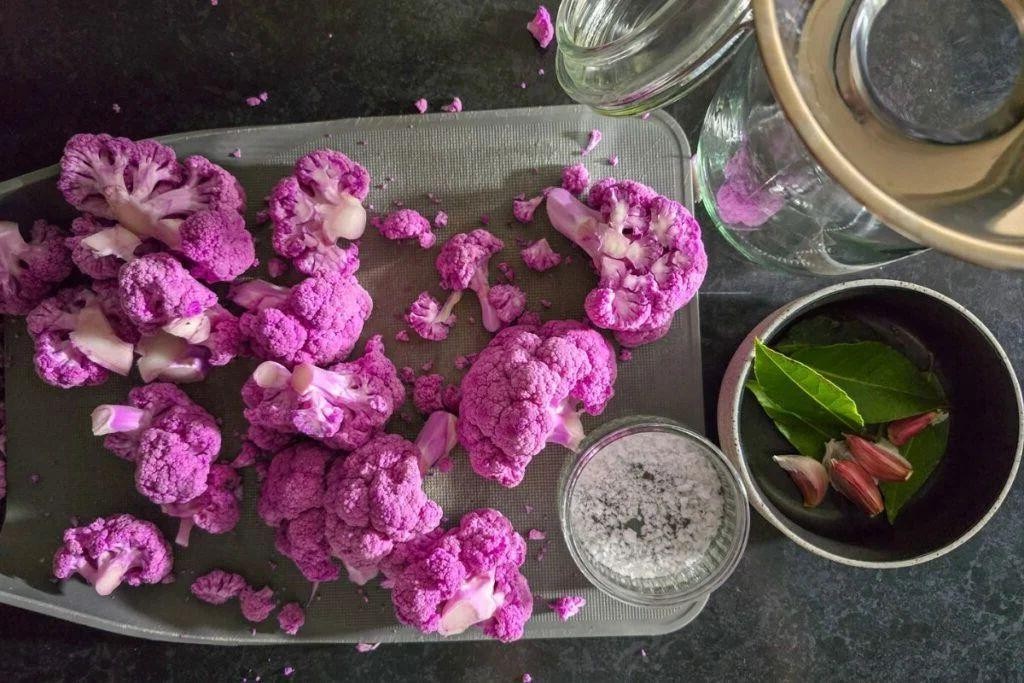
Transform ordinary cauliflower into a tangy, probiotic-rich snack with this simple recipe for fermented cauliflower florets. Perfect as a side dish or used as an ingredient in salads and sandwiches.
Ingredients:
– 1 head of cauliflower
– 1 tablespoon sea salt
– 1/2 cup water
– 1 tablespoon chopped fresh dill (optional)
Instructions:
1. Preheat your oven to 400°F (200°C).
2. Rinse the cauliflower florets and remove any leaves or stems.
3. In a bowl, mix together the sea salt and water to create a brine.
4. Add the cauliflower florets to the brine and make sure they are fully submerged.
5. Cover the bowl with cheesecloth or a clean cotton cloth and let it sit at room temperature for 24-48 hours.
6. After fermentation, rinse the cauliflower florets with water and pat them dry.
7. Toss with chopped fresh dill (if using) and serve.
Cooking Time: 0 minutes (fermentation time is variable, depending on desired level of sourness)
Fermented Zucchini Coins
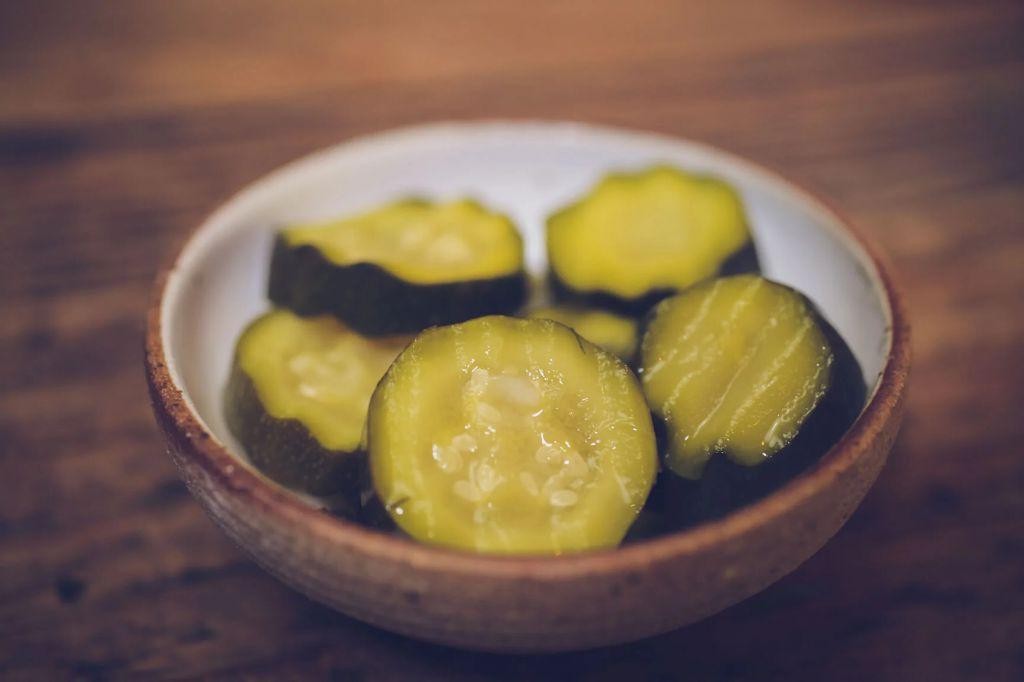
Transform zucchinis into tangy, crunchy coins by fermenting them in a flavorful brine. This recipe is perfect for adding a burst of probiotic-rich flavor to your meals.
Ingredients:
– 4 medium-sized zucchinis
– 1 cup water
– 1/2 cup salt
– 1 tablespoon caraway seeds (optional)
– 1 teaspoon black pepper
Instructions:
1. Slice the zucchinis into coins, about 1/8 inch thick.
2. In a large bowl, mix together the water and salt until dissolved.
3. Add the zucchini coins to the brine and let them sit at room temperature for 24 hours.
4. After 24 hours, stir in caraway seeds (if using) and black pepper.
5. Transfer the zucchini coins to an airtight container and store it in the refrigerator.
6. Allow the fermentation process to continue for another 2-3 days or until you reach your desired level of tanginess.
Cooking Time: 24 hours + storage time
Fermented Rainbow Chard Stems
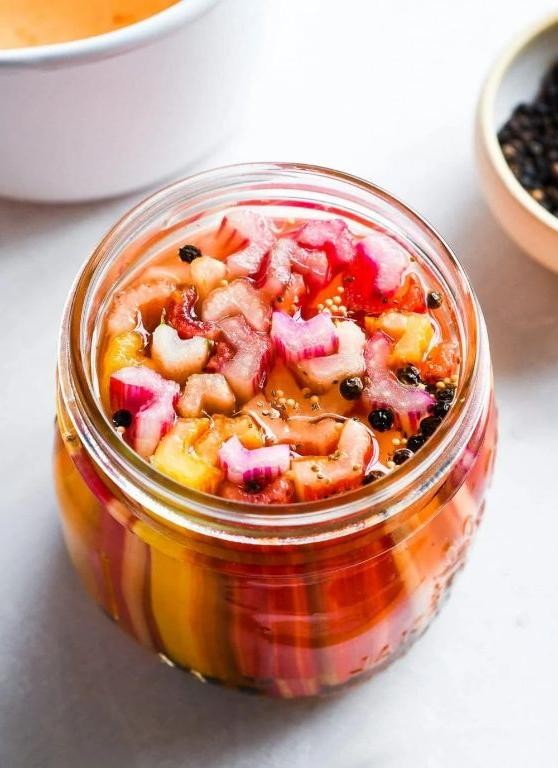
Fermented Rainbow Chard Stems Recipe
Elevate your culinary game with this simple and flavorful recipe that turns the humble rainbow chard stems into a tangy, fermented delight. Perfect as a side dish or used as an ingredient in various recipes.
Ingredients:
– 1 bunch of rainbow chard stems
– 1/4 cup of water
– 1 tablespoon of salt
– 1 tablespoon of sugar
Instructions:
1. Rinse the chard stems under cold running water, then chop them into 2-inch pieces.
2. In a large bowl, combine the chopped chard stems and water. Let it sit for 30 minutes to allow the stems to rehydrate.
3. In a separate bowl, mix together the salt and sugar until dissolved.
4. Add the brine mixture to the chard stem mixture and stir well to combine.
5. Transfer the mixture to a clean glass jar or container with a wide mouth.
6. Weigh down the chard stems with a plate or stone to keep them submerged under the liquid.
7. Cover the jar or container with a cloth or paper towel, securing it with a rubber band.
Cooking Time:
– Fermentation time: 3-5 days
– Storage time: Store in the refrigerator and consume within 1 month
Summary
Discover the power of fermented vegetables for gut health with these 18 tangy recipes! From spicy kimchi to probiotic sauerkraut, and from pickles to beet kvass, each recipe harnesses the benefits of fermentation to promote digestive well-being. Try Spicy Fermented Kimchi with Napa Cabbage, Garlic-Dill Fermented Pickles, or Fermented Carrot Sticks with Turmeric – there’s something for every taste bud. With simple instructions and a range of ingredients, you can easily add these fermented delights to your daily routine and start reaping the rewards for your gut health.
Leave a Reply